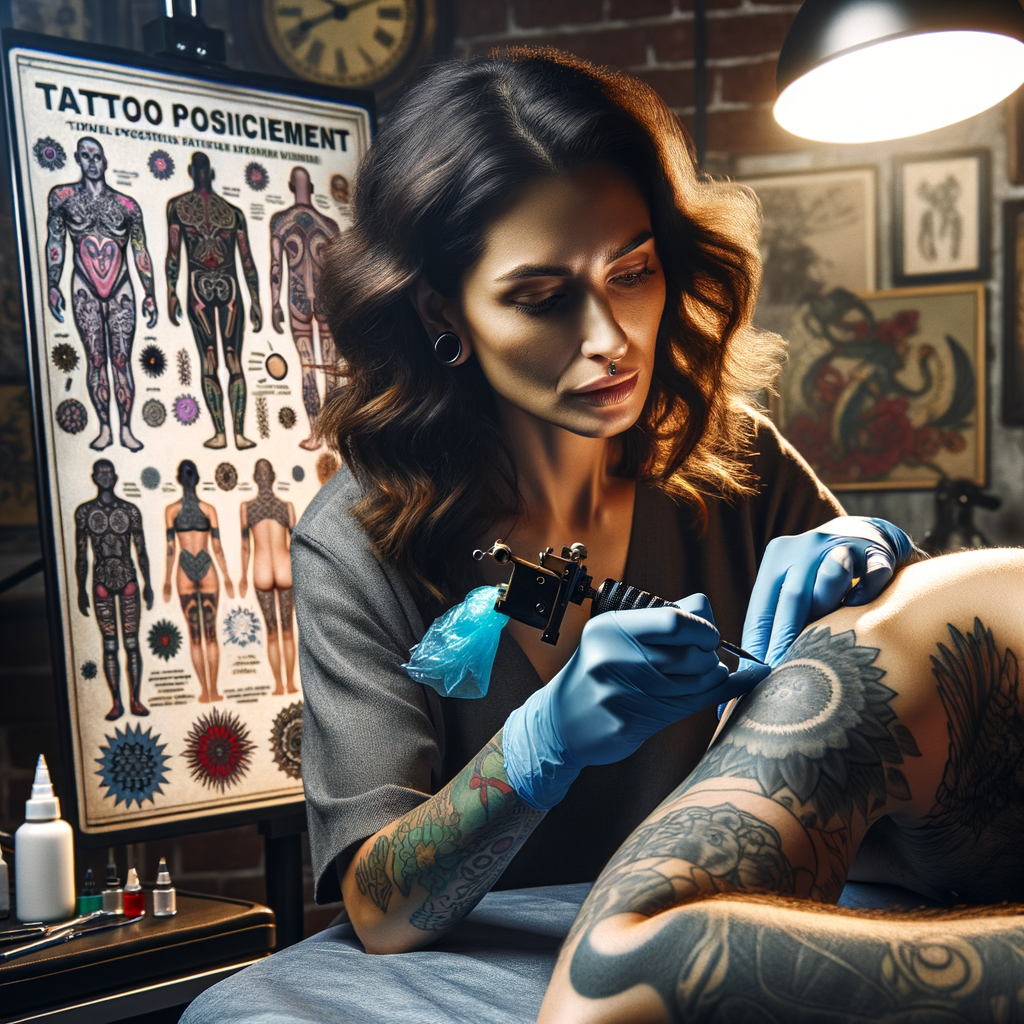
Introduction to Perfect Tattoo Placement
Getting a tattoo is a big decision. It’s not just about choosing the right design, but also about finding the perfect place on your body to ink it. In this blog post, we will explore the art of tattooing and the importance of tattoo placement.
-
- Understanding the Art of Tattooing
Tattooing is an ancient art form that has been practiced for thousands of years. It involves injecting ink into the skin to create permanent designs. The process requires skill, precision, and a deep understanding of the human body. A good tattoo artist knows how to work with the contours of the body to create a tattoo that looks good from all angles.
-
- Importance of Tattoo Placement
The placement of a tattoo can greatly affect its appearance and meaning. For example, a tattoo on the arm might be more visible and make a bold statement, while a tattoo on the back might be more personal and hidden. The placement can also affect the pain level during the tattooing process. Some areas of the body, like the ribs or the foot, are more sensitive than others.
Choosing the right placement for your tattoo is a personal decision. It’s important to think about your lifestyle, your comfort level, and the message you want to convey with your tattoo. Remember, a tattoo is a form of self-expression and should be a reflection of who you are.
In the following sections, we will provide a detailed guide on tattoo placement, discuss different positioning techniques, and share some creative tattoo placement ideas. Stay tuned to master the art of perfect tattoo placement!
Tattoo Placement Guide
Getting a tattoo is a big decision. It’s not just about choosing the right design, but also about deciding where on your body you want it. This guide will help you make an informed choice.
Professional Tattoo Placement Tips
Here are some professional tips to help you decide the perfect spot for your tattoo:
-
- Choosing the Right Location for Your Tattoo
The location of your tattoo can say a lot about you. Some people choose to have their tattoos in visible places to showcase their personality, while others prefer more discreet locations. Here are a few things to consider:
-
-
- Visibility: Do you want your tattoo to be seen by everyone, or would you prefer it to be more private? Remember, some workplaces may have policies about visible tattoos.
- Pain tolerance: Some areas of the body, like the ribs or feet, are more sensitive than others. If you have a low pain tolerance, you might want to consider getting your tattoo in a less sensitive area.
- Body changes: Keep in mind that your body may change over time. Areas like the stomach or breasts might not be the best choice if you plan on losing weight or getting pregnant in the future.
- Understanding Tattoo Placement and Body Movement
-
Another important factor to consider is how your tattoo will move with your body. Tattoos on certain parts of the body can stretch or distort as you move. Here’s what you need to know:
-
- Movement: Areas that move a lot, like the elbow or knee, might cause your tattoo to warp over time.
- Ageing: As you age, your skin will naturally lose elasticity. This can cause tattoos in certain areas to sag or blur.
- Size and design: Larger tattoos or designs with a lot of detail might look better on flatter, larger areas of the body, like the back or chest.
Remember, the most important thing is that you’re happy with your tattoo. It’s a personal decision, and what matters most is that it feels right for you.
Tattoo Positioning Techniques
One of the most critical aspects of tattooing is the positioning of the design. This requires a combination of artistic skill, technical knowledge, and understanding of the human body. In this section, we will explore two main techniques used by professional tattoo artists to ensure perfect positioning: using stencils and freehand drawing.
Mastering Tattoo Art
Mastering the art of tattooing is not just about being able to create beautiful designs. It’s also about understanding how to place those designs on the body in a way that complements the client’s physique and personal style. Let’s delve into the two key techniques that can help you achieve this.
-
- Using Stencils for Tattoo Placement
Stencils are a popular tool in the tattoo industry. They allow artists to transfer a design onto the skin accurately, ensuring the correct positioning and size. This method is particularly useful for complex designs that require precision.
Here’s how it works: The artist first sketches the design onto a special stencil paper. This paper is then placed onto the desired area on the client’s body, transferring the design onto the skin. The artist can then trace over the stencil with the tattoo machine. This technique ensures that the final tattoo is exactly as planned, with no room for error in positioning or scale.
-
- Freehand Drawing for Tattoo Placement
Some artists prefer to use freehand drawing for tattoo placement. This method involves the artist drawing the design directly onto the skin using a non-permanent marker. Freehand drawing allows for greater flexibility and creativity, as the artist can adjust the design to fit the client’s body perfectly.
While this technique requires a high level of skill and confidence, it can result in unique, personalized tattoos that truly reflect the client’s individuality. However, it’s important to remember that freehand drawing should only be attempted by experienced artists, as it leaves little room for error.
Whether using stencils or freehand drawing, the key to successful tattoo positioning is practice and patience. Remember, a tattoo is a permanent mark on the body, so it’s essential to get it right the first time. With the right techniques and a lot of practice, you can master the art of tattoo positioning.
Tattoo Placement Ideas
Deciding where to place your tattoo is as important as choosing the design itself. The location of your tattoo can convey different meanings and can either highlight or hide the artwork. Let’s explore some popular and unique tattoo placement ideas.
Exploring Different Tattoo Locations
There are numerous locations on the body where you can place a tattoo. Each location has its own unique appeal and significance. Here are some popular and unique tattoo placement ideas.
-
- Popular Tattoo Locations and Their Meanings
Some of the most popular tattoo locations include the wrist, ankle, shoulder, and back. Each of these locations has its own unique meaning:
| Location | Meaning |
|---|---|
| Wrist | Often symbolizes a journey or a path in life. |
| Ankle | Can represent stability and grounding. |
| Shoulder | May symbolize carrying a burden or responsibility. |
| Back | Often represents a canvas for larger, detailed artworks. |
Remember, the meaning of a tattoo can vary greatly depending on personal beliefs and cultural backgrounds.
-
- Unique Tattoo Placement Ideas
If you’re looking for something a bit different, consider these unique tattoo placement ideas:
-
-
- Behind the Ear: A small and discreet location, perfect for a small symbol or word.
- Finger: A popular choice for small, simple designs or words.
- Collarbone: This location can highlight delicate and elegant designs.
- Under the Breast: An intimate location that can be easily concealed.
-
These unique locations can make your tattoo stand out and add an extra layer of personal significance to your artwork.
Choosing the right tattoo placement can enhance the beauty and meaning of your tattoo. Take your time to consider the best location for your design and personal style.
Understanding Tattoo Placement
When it comes to getting a tattoo, one of the most important decisions you’ll make is where to place it on your body. This decision can affect not only how your tattoo looks, but also how much it hurts to get it. In this section, we will delve into the topic of tattoo placement and pain, discussing the most sensitive areas and providing tips on how to minimize discomfort.
Tattoo Placement and Pain
It’s important to understand that the level of pain you experience when getting a tattoo can vary depending on the placement. Some areas of the body are more sensitive than others due to the presence of more nerve endings or less fat padding. Let’s explore this in more detail.
-
- Which Areas are Most Sensitive?
Areas with thin skin and many nerve endings, like the ribs, feet, and hands, are often reported as the most painful places to get a tattoo. The inner arm, wrist, and ankle can also be quite sensitive. On the other hand, areas with more fat or muscle, like the upper arm, thigh, or calf, are generally less painful.
-
- How to Minimize Tattoo Placement Pain
There are several strategies you can use to minimize tattoo placement pain. First, consider getting your tattoo in a less sensitive area if you’re concerned about pain. Second, make sure you’re well-rested and hydrated on the day of your appointment, as this can help your body better cope with the pain. Lastly, don’t hesitate to communicate with your tattoo artist about your pain tolerance. They can adjust their technique or take breaks as needed to make the process more comfortable for you.
Remember, everyone’s pain tolerance is different, and what might be painful for one person might not be for another. It’s important to choose a tattoo placement that you’re comfortable with and that will allow you to best express your personal style.
In the next section, we will dive deeper into the art of perfect tattoo placement, discussing various positioning techniques and providing a guide to help you make the best decision for your unique tattoo.
Tattoo Placement Mastery
Mastering the art of tattoo placement involves understanding the body’s anatomy, cultural significance, and personal preferences. In this section, we’ll delve into two case studies that highlight successful tattoo placements.
Case Studies: Successful Tattoo Placement
Let’s explore two different scenarios where tattoo placement played a significant role in the overall success and acceptance of the tattoo.
-
- Case Study 1: Celebrity Tattoo Placement
Celebrities often set trends in the world of fashion and style, and tattoos are no exception. Take, for example, the famous singer Rihanna. She has a trail of stars cascading down her back, which is not only aesthetically pleasing but also symbolizes her rise to stardom. This tattoo placement is strategic as it can be easily concealed or showcased depending on her outfit choice.
-
- Case Study 2: Cultural Tattoo Placement
In many cultures, tattoo placement holds significant meaning. For instance, in Maori culture of New Zealand, facial tattoos, or ‘Ta Moko’, are a symbol of status and identity. The intricate designs and placement on the face represent the person’s lineage, skills, and social standing. This case study demonstrates the importance of understanding cultural implications when considering tattoo placement.
In conclusion, successful tattoo placement requires a blend of personal preference, understanding of body anatomy, and cultural awareness. Whether you’re a celebrity looking to make a style statement or someone honoring their cultural heritage, the right tattoo placement can enhance the overall impact and meaning of your tattoo.
Conclusion: The Art of Perfect Tattoo Placement
Perfect tattoo placement is an art that requires careful thought and consideration. It’s not just about where the tattoo will look good, but also about what it represents and how it aligns with your personal and cultural identity. Remember, a tattoo is a lifelong commitment, so take your time to decide on the perfect placement.
Conclusion: The Art of Perfect Tattoo Placement
As we draw to a close on our journey through the art of perfect tattoo placement, it’s time to reflect on the key insights we’ve gathered. Tattoo placement is not just a matter of aesthetics, but also a reflection of personal expression and meaning. It requires careful thought, planning, and mastery of various techniques.
-
- Key Takeaways for Mastering Tattoo Placement
Understanding the art of tattoo placement is crucial for achieving the desired result. Here are some key takeaways:
-
-
- Always consider the size and design of the tattoo in relation to the chosen placement area.
- Remember that different areas of the body can influence the perception of the tattoo’s shape and size.
- Consider the visibility and personal significance of the tattoo placement.
- Always consult with a professional tattoo artist for advice on optimal placement.
- Final Thoughts on Tattoo Placement Techniques
-
Mastering tattoo placement techniques is a journey, not a destination. It requires continuous learning and practice. Here are some final thoughts:
-
- Understanding the body’s anatomy is crucial for effective tattoo placement.
- Practice on synthetic skin or fruit before attempting on human skin.
- Always prioritize the client’s comfort and safety.
- Keep honing your skills and staying updated with the latest tattoo placement trends and techniques.
In conclusion, the art of perfect tattoo placement is a blend of technical skill, artistic vision, and understanding of the human body. It’s about creating a piece of art that not only looks good but also resonates with the wearer on a personal level. Remember, a tattoo is a permanent mark, and its placement can make all the difference.






